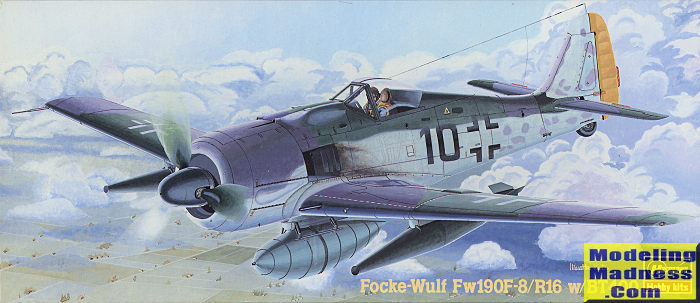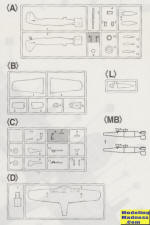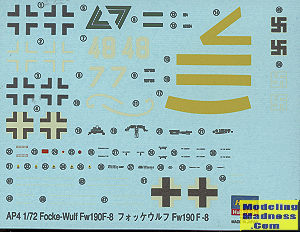
Hasegawa 1/72 FW-190F-8/R16 w/BT 400
| KIT #: | 51372 (AP 112) |
| PRICE: | 1500 yen SRP when new |
| DECALS: | One option |
| REVIEWER: | Scott Van Aken |
| NOTES: | 1995 release |

| HISTORY |
The BT 400 bomb torpedo was a non-propulsion torpedo . This was dropped in a straight line on the target while flying low. The only propulsion used was the kinetic energy of the torpedo. The new type of drop ammunition for the Fw 190 was launched in spring 1943 by Dr. Benecke proposed by the “Technical Air Armament” department.
The main advantage of the BT was that it was simple and cheap to manufacture (the body was made of cast iron, the stern was made of sheet steel). For example, while a normal F5 air torpedo required 2000 working hours, the BT could be produced in 60 hours. It was able to carry a little more explosives , needed fewer scarce raw materials because of the lack of a drive and needed a total of about 240 kg less material.
The first tests were carried out in the Niedersonthofener See near Kempten (Allgäu) . However, the development of target devices, detonators and other individual parts prevented the use of this weapon.
There were several sizes (BT 200, BT 400, BT 700 A, BT 700 B, BT 1000, BT 1850).
| THE KIT |
 For
many years, the Hasegawa 1/72 FW-190 series was the best there was. Earlier
offerings from a variety of manufacturers, including an earlier Hasegawa kit,
were all lacking, with shape errors that were difficult to correct. This one was
first tooled in 1992, followed by literally dozens of boxings, several of them
being combo kits. The last ones were released in 2014/2015, probably due to the
more detailed Academy, Revell, Zvezda, Airfix, and later Eduard kits. All of
Hasegawa's 1/72 190s were A-5 and later variants. They also did the 190D-9.
For
many years, the Hasegawa 1/72 FW-190 series was the best there was. Earlier
offerings from a variety of manufacturers, including an earlier Hasegawa kit,
were all lacking, with shape errors that were difficult to correct. This one was
first tooled in 1992, followed by literally dozens of boxings, several of them
being combo kits. The last ones were released in 2014/2015, probably due to the
more detailed Academy, Revell, Zvezda, Airfix, and later Eduard kits. All of
Hasegawa's 1/72 190s were A-5 and later variants. They also did the 190D-9.
These kits are not complex and don't suffer from a plethora of small parts that one often deals with when it comes to newer kits. The cockpit is a simple tub with a seat, stick and instrument panel. Decals for the instrument faces. This is trapped in the fuselage halves and the upper cowling, tailplanes and prop assembly are then attached. The prop comes with separate, keyed, blades. Then one assembles the wing, opening any holes that are required and for the G-8, the variant of this kit, you will need to open some holes. You also need to trim away some pieces and fill holes as this plane did not have outer wing guns.
Landing gear is simple and sturdy. A centerline rack is provided for a drop tank. To provide for the special boxing, a pair of BT 400s with the pylon molded in place are provided in cast metal. The casting is well done and requires little in the way of clean-up. These kits have the pitot tube and tail gear molded in place so care does need to be taken when building. The canopy and windscreen are separate with this kit only offering the 'blown' version.
 You
get the standard FW-190F-8 instruction sheet and decal sheet, which you'll use
for insignia, stencils and the instrument decals. Not shown is a separate small
sheet with a variety of fuselage numbers in black. A separate instruction sheet
is included so that you can make all the modifications needed for this boxing.
This involves opening up quite a few holes, filling others and removing some
bits, so be aware this is needed and use the addendum sheet as required. The
aircraft on the box art has a yellow rudder as well as light rear fuselage
mottling on a standard RLM 74/75/76 camouflage scheme.
You
get the standard FW-190F-8 instruction sheet and decal sheet, which you'll use
for insignia, stencils and the instrument decals. Not shown is a separate small
sheet with a variety of fuselage numbers in black. A separate instruction sheet
is included so that you can make all the modifications needed for this boxing.
This involves opening up quite a few holes, filling others and removing some
bits, so be aware this is needed and use the addendum sheet as required. The
aircraft on the box art has a yellow rudder as well as light rear fuselage
mottling on a standard RLM 74/75/76 camouflage scheme.
| CONCLUSIONS |
Will this be an easy kit to build? Yes it will. The addition of the BT 400s makes this somewhat of a 'whiffer' as no unit actually used them. As such, the builder has the freedom to use other unit markings on this if they so desire. A quick google did turn up one of these (for $35) so they are out there if you want one.
| REFERENCES |
https://second.wiki/wiki/bombentorpedo_bt_400
July 2022
Copyright ModelingMadness.com. All rights reserved. No reproduction in part or in whole without express permission.
If you would like your product reviewed fairly and fairly quickly, please contact the editor or see other details in the Note to Contributors.